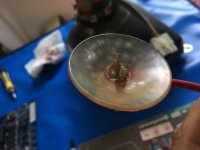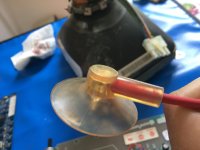Alex
Well-known member
Hello
I am doing a complete cleanup and visual inspection before I go through repairing the logic board. Anyway, I noticed that once I removed the anode cap a red sticky material was found on the anode cap and the anode aperture.
I wonder what this material is, I imagine it is there to act as a glue to keep the cap in place, or at least help it stay in place.
I am wondering if anyone has more info and whether this material is critical if so, I have wiped some off when it occurred to me that it is likely needed.
I would truly appreciate any information.

Kind regards
—Alex Santos
I am doing a complete cleanup and visual inspection before I go through repairing the logic board. Anyway, I noticed that once I removed the anode cap a red sticky material was found on the anode cap and the anode aperture.
I wonder what this material is, I imagine it is there to act as a glue to keep the cap in place, or at least help it stay in place.
I am wondering if anyone has more info and whether this material is critical if so, I have wiped some off when it occurred to me that it is likely needed.
I would truly appreciate any information.

Kind regards
—Alex Santos


